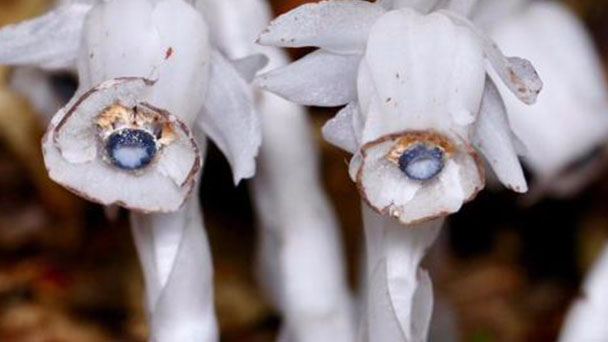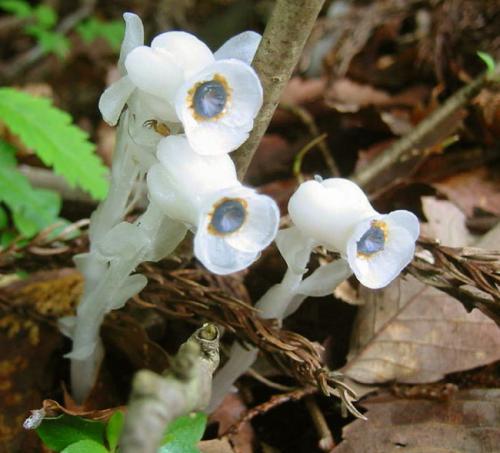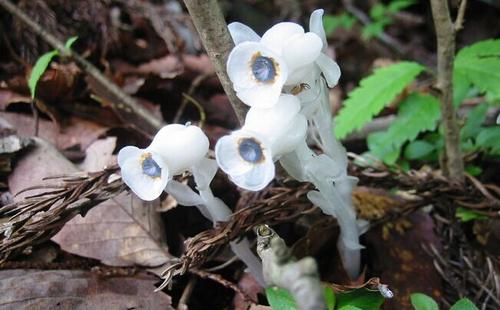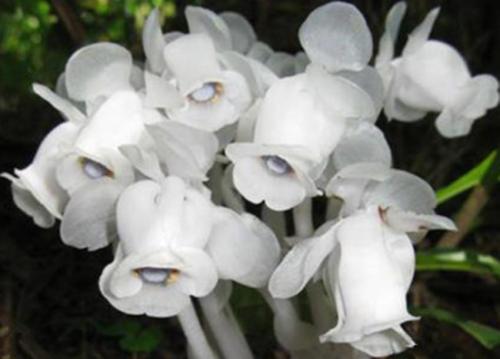Indian pipe (Monotropa uniflora) profile
Written by Maggie
Mar 15 2021

The Indian Pipe is neither an orchid nor a mushroom. Indian pipe belongs to the wintergrass family. The whole body has no chlorophyll, so it can not photosynthesize, is to rely on decaying plants to obtain nutrients, known as the flower of death. The flowers of Indian Pipe are shining white in the dark, wet leaf leaves. There are crystal pipes.
Indian pipe picture

Morphological characteristics of Indian pipe
The Indian pipe is a parasitic plant without chlorophyll, with scaly leaves and a densely branched root system that is covered with mycorrhiza to extract nutrients from the soil. Some scholars have argued that it should be separated from the Pyrolaceae family and become its own family.Herbs, scaly; The roots are slender and interwoven; Flowers are single terminal, pendulous first, erect later, bracts, scalelike, caducous; indian pipe has 5-6 petals, free, long elliptic, without cysts at base, with irregular teeth, often densely long hairs on the inside, caducous; Indian pipe has 10-12 stamens, anthers short, peltate, native, transverse filaments 0.8 -- 1.2 cm long, hispid, anthers yellow. Disk adheres to the base of the ovary, extending into 10-12 teeth. Ovary is 5-loculed, axial placenta, each locule with numerous ovules, style short, thick, style 2 -- 3 mm long, distally enlarged into a funnel-shaped stigma; Capsule is elliptic globose, erect, upward, ca. 1.3-1.4 cm long, 5-lobed, locular-dorsum dehiscent into 6 fruit petals; Seeds are minute, subcylindrical.
Stems of Indian pipe are erect, simple, unbranched, 10-30 cm tall, chlorophylless throughout the plant, white, fleshy, dark-brown after drying. Roots are thin and densely branched, intersected into a nest. Leaves are scaly, erect, alternate, oblong or narrowly oblong or broadly lanceolate, 1.4 -- 1.5 cm long, 4 -- 4.5 mm wide, apex obtuse, glabrous or distal leaves slightly hairy, margin sub entire. Flowers of Indian pipe simple, terminal, first pendulous, then erect, corolla tubular campanulate, 1.4-2 cm long, 1.1-1.6 cm in diameter; Bracts are scaly, homomorphic to leaves; Sepals are scalelike, caducous; Indian pipe has 5-6 petals, free, cuneate or ovate-oblong, 1.2-1.6 cm long, 5.5-7 mm widest distally, with irregular teeth, often thickly hirsute medially, caducous; Indian pipe has 10-12 stamens, filaments hirsute, anthers yellow; Disk is 10-dentate; Ovary is axial placenta, 5-loculed; Style is 2 -- 3 mm long, stigma puffed into funnelform. Capsule is ellipsoid, erect, upward, 1.3-1.4 cm long.
Indian pipes in the natural environment are mostly clustered, but rarely isolated. Its whole plant height is about 10cm ~ 15cm, in thousands of years of evolution, its leaves have degenerated into white scales, alternate on unbranched fleshy stems, monoecious, single flowers at the top of the plant. The white transparent leaves of Indian Pipe have degenerated into scales attached to the sides of the stem, alternate, white. The stem is also white and unbranching. The flowers are monoecious from spring to summer. In May and June, they grow long bell-shaped white flowers from the top of the stem, sometimes in clusters and at the top of each plant. The Indian pipe grows at an altitude of 1,500 to 2,500 meters and is common in cool, damp coniferous and broad-leaved forests.
Ecological habits of Indian pipe
Growing habits: Indian pipe grows at an altitude of 1500-2500 m. It is commonly found in cool, damp coniferous and broad-leaved mixed forests.
Distribution area of Indian pipe
Indian pipe grows at an altitude of 1,500 to 2,500 meters and is found in cool, damp coniferous and broad-leaved mixed forests.
There are five known species of Indian pipes in the world, of which there are about two in China. They are mainly distributed in Zhejiang, Shanxi, Shaanxi, Gansu, Qinghai, Hunan, Taiwan, Sichuan, Yunnan, Guizhou and other regions. Most of them grow in the cool and wet mixed coniferous and broad-leaved forests at an altitude of 800m ~ 3000m, so people rarely see them.
More specific distribution: Kunming, Tengchong, Haoming, Luquan, Chuxiong, Jingdong, Menghai, Xichou, Guangnan, Lijiang, Zhongdian, Deqin; They are born under forests on hillsides, 1 650-3 200 m above sea level. Shanxi, Shaanxi, Gansu, Qinghai, Zhejiang, Anhui, Taiwan, Hubei, Jiangxi, Sichuan, Guizhou, Xizang and other provinces have distribution.Russia, Japan, India, Southeast Asia, North America are also distributed.
Indian pipe is concentrated in southwest and northwest China.Some botanists have recorded Northeast China (Heilongjiang 1), Jilin 2). However, Indian pipe has never been found or contacted in Northeast China. At the same time, we have also studied the specimens of this species and found that all the species recorded in Northeast China were the fault of dwarf pseudoIndian pipe Cheilotheca humilis (D. Don) H. Keng (see the description of this species). Therefore, there is no distribution of Indian pipe in Northeast China.

Growing Indian pipe
Growing seedlings is the key to cultivating Indian pipe flowers. How to grow seedlings? The first thing to do is to keep the number of plants. That is, the dividing plant can not be too fine, as far as possible to maintain above three seedlings, conjoined cultivation.
Cultivation the environment as far as possible to achieve adequate air temperature, while maintaining light foot, water foot, promote the growth of orchid seedlings, keep the orchid seedlings healthy. Protecting the growth of the orchid depends on the absorption of nutrients by the root. Blackened or rotting root tips prevent the roots from delivering water and nutrients to the plant. That is the main cause of the charred Indian Pipe. Therefore, to protect the root, must maintain a pot of hydrophobic breathable, watering to pour through, not outside the wet inside dry;In summer, orchid roots should be rinsed regularly to avoid residual fat water retained in the basin and root damage.
Increasing Indian Pipe Humidity Increasing Indian Pipe Humidity is an important condition for a good Indian Pipe. The humidity of the orchid shed is uneven. Especially in the hot summer and early spring, the evaporation of the orchid plant is too large, resulting in the scorching of the Indian pipe. Therefore, we should try to increase the humidity of the orchid shed to keep it above 70%. Do not touch or damage the orchid Indian pipe crystals with your hands when growing.
Do as little as possible, change the basin, avoid injury and root tip, and affect the growth of orchid strains.Choose fertile soil that is permeable and breathable.
Uses of Indian pipe
Watch
But in the humus soil, where there is not a single green leaf, there is a lovely white flower. It is the Indian Pipe. When walking in the middle and high altitude mountainous areas during the transition of spring and summer, you can often see it blooming on a pile of insignificant soil, which is really amazing.
In nature, Indian Pipe is not a rare ghost, but one that can be seen by anyone who knows their habits, chooses their place, and chooses their time. The best time to see an Indian Pipe is around mid-April in the south and a little later in the north. This is the perfect time to see an Indian Pipe. Too early, Indian Pipe has not sprouted yet; Too late, the Indian Pipe will get brown spots as it ages, making it impossible to appreciate its clear, dreamlike beauty.
The Indian pipe's unique plant habits make it uniquely suited to a cool, humid, humus climate in the mountains and forests. It relies on specific bacteria to survive. Unless it can be grown to mimic its native environment, it is unlikely to survive in a normal artificial environment. And the seeds of the Indian Pipe are so tiny that they contain almost no nutrients, leaving their native place to sprout under artificial conditions. The Indian Pipe has only a few short months to go from sprout to blossom and bear fruit in the spring. Only in a good and harmonious environment can the Indian Pipe thrive. Accordingly, below the circumstance that the condition does not have, we do not want to change at will, destroy its living space. Perhaps in the near future, developed science and technology will help this beautiful spirit from the mountains and forests, into our lives, to bring joy and pleasure to more people.
Medicinal value
Indian pipe contains Indian pipe side (Monotropein), β-sitosterol, p-coumaric acid, ursolic acid, glucose, sucrose and raffinose. Monoglucose and diglucosinolates containing kaempferol and quercetin, sterols, mainly sitosterols, fatty acids, mainly fatty acids with 16-18 carbons and a small amount of linolenicacid.

Latest Updated
- Benefits of Bugleweed - 7 Science-backed Health Benefits
- Bugleweed Dangers & Side Effects - Is It Poisonous?
- How to Plant Evergreen Trees - What You Should Know
- When to Plant Evergreens - Grow Guide for Evergreen Trees
- 12 Wonderful Evergreen Shrubs for Your Garden
- 12 Popular Evergreen Plants with Pictures for Beginners
- When And How To Prune A Lilac Bush Like a Pro
- How to Grow & Care for Lilac Vine (Hardenbergia Violacea)
- Japanese Lilac Tree (Syringa Reticulata) Care & Propagation Guide
- Shumard Oak Pros and Cons - What to Know
Popular Articles
- Winter maintenance of Antirrhinum Majus
- How to Grow Terminalia Mantaly Tree
- How to Grow and Care for Crossostephium Chinense
- How to grow Antirrhinum Majus in spring
- Peristeria Elata (Dove Orchid) Profile: Info & Care Guide
- Underwatered Snake Plant (Sansevieria Trifasciata) - Signs And How To Fix
- How to Care for Brazilian Jasmine Plant (Mandevilla Sanderi)
- How to Grow & Care for Graptopetalum Purple Delight in Summer
- Rosa Chinensis (China Rose): Plant Growing & Care Tips
- How to Care for Baby Sun Rose (Aptenia Cordifolia)